Packaging And Seating Applications For Highly Engineered Foams
Comfort, safety and environmental considerations have provided the impulse for the development of highly engineered foams. These foams are based on urethanes, polyethylenes and polystyrenes and have many uses as shock absorbers, packaging for foods and appliances and safety equipment.
Seating
High resilience urethane foams are used widely in seating, but the comfort they provide is a subjective matter. Some people find the product too hard. This is because when a person sits on the foam cushion, it reacts to the compressive force of the person’s weight by behaving like a spring. It returns an equal force and causes the occupant’s weight to be distributed unevenly. The occupant is forced to shift around in the seat to find a more comfortable position. Seating should also protect the occupant from an impact. This is of importance to the automotive, airline and space industries. However, some of the standard urethane foams may amplify the force of the impact and creating damage and injury rather than protection.
Engineering Development
The solution has been to develop a foam product that feels soft in response to a slow pressure, usually a normal sitting position for a seat occupant. It must be firm in response to a sudden impact and should not recoil like a spring. It should also absorb the load and dissipate the energy, usually in the form of heat. Polystyrene-based thermoplastic foams are strong, lightweight and energy absorbent. They have a closed cell structure and can be installed within vehicle cavities. This enhances passenger safety during any impact or accident. Some highly engineered foam products are used in custom bedding design. Ingredients are mixed into polyurethane and latex foams after the initial foam is poured and set. Some silver additives provide an anti-bacterial protection, odours can be controlled with additional carbon whilst a choice of essential oils can help to induce relaxation and sleep.
Packaging
The increase in waste plastic packaging products, from plastic bags to rigid coverings, has attracted a rising tide of critics for the environmental impact. Packaging engineers have been working with the plastics industry to develop biodegradable products. One of the initial developments was a type of polyethylene foam made from low density polyethylene sheets. This product does not biodegrade with normal use but only degrades when placed in microbe rich environments such as landfills. Standard plastic accumulates in landfills and can remain intact for many years.
Conclusion
Biopolymers are today’s cutting edge for highly engineered foams. These are known chemically as polysaccharides and are found in brown seaweeds. When processed in the presence of calcium ions they form foams and gels that have a variety of medical and industrial uses. They can be made to be biocompatible with mammalian tissue and are used in wound management, controlled drug release, medical implants and in vitro cell support. They can be engineered to have extra strength and not become brittle. Some of these foams have the ability to immobilise particulates, drugs or living cells within the pores of the foam. If necessary, they can also be made to be biodegradable.
AUTHOR BIO:
Alisa Martin is a research biochemist who has worked in the plastics industry over the last 20 years. One of her current research projects is to develop highly engineered foam products for medical applications.

Category: Business






